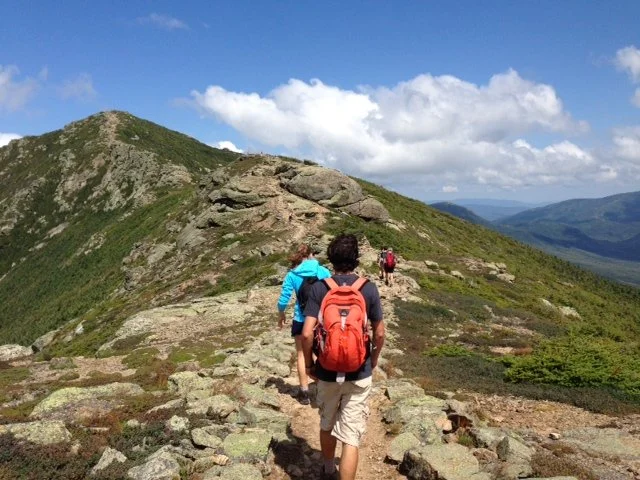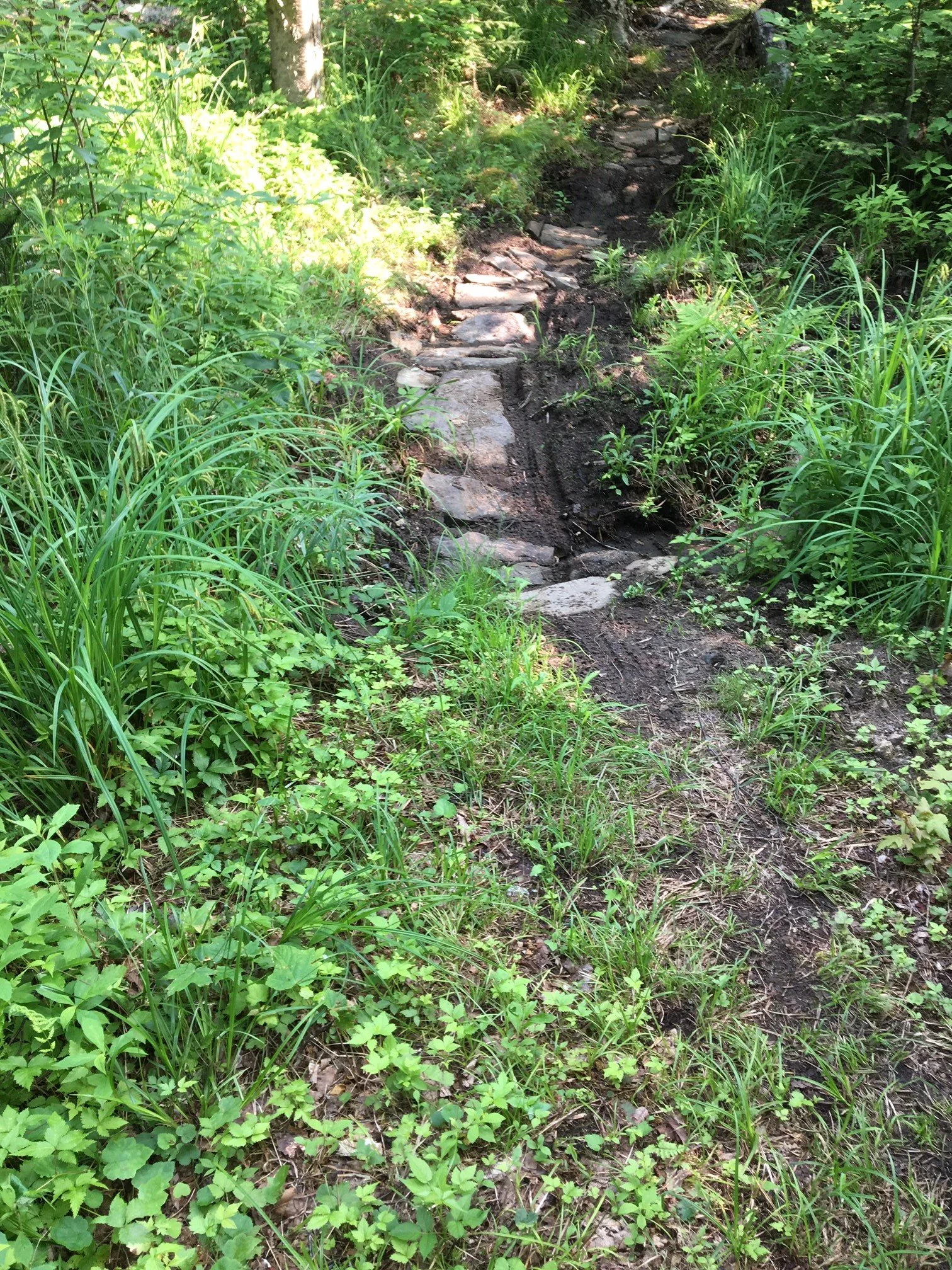
Reflections on Water - Chapter 6, Reflections on Water and Trails
Chris Nicodemus & Katrina Meserve
With Mud season now behind us, the landscape drying out, and the countryside beckoning, Katrina and I shift our attention to the complex relationship between trails and water. This conversation starts with the recognition that the term trail encompasses a wide range of meanings. The term conjures very different images and very different perspectives depending on the audience or reader. A trail might be a heavily engineered adaptive trail or a barely traceable path through the undergrowth.
The mission of the Ammonoosuc Conservation Trust is to foster the appreciation of our natural environment and selective conservation methods that lead to a more sustainable world, natural habitats for all, and land use practices that allow for progress with economic growth while minimizing adverse consequences to both the natural environment and our neighbors. ACT recognizes the value of trails in introducing the public to nature and providing educational and recreational opportunities and access to natural spaces with a goal of generating a deeper appreciation of the natural world by everyone in our community.
The word trail can mean literally a trail of “bread crumbs” left behind so one can retrace one’s steps through a confusing terrain, or a subtly established route through a thickly vegetated terrain in which branches have been trimmed to avoid eye injury in the absence of an evident tread, a multiuse footpath well marked and free of obstacles, or perhaps a widened and graded passageway engineered to exacting specifications required by the Americans with Disabilities Act. At the limit even an interstate highway might be considered a trail.
There is also the perspective of the intended user to consider. Walkers, mushroom gatherers, trail runners, snowshoers, skiers, road bicyclists, mountain bicyclists, equestrians, snowmobilers, ATV users all have very different needs and requirements for the trails that they prefer. Some trails are strictly recreational and intended to take one on a meandering circuit returning to the origin, whereas others are part of a network and a mode of transportation dependent on continuity, interconnection and efficiency to serve its purpose.
Some trails are created by animals in a seasonal routine where they repeatedly pass the same route, and human trails often become co-opted by wildlife and vice versa. Nature trails can be evanescent with shifting routes depending on ground conditions, water, and obstacles. The human desire to precisely map a trail and insist that it be followed exactly often conflicts with the practical reality on the ground. Trail project funding may require deeded right of way and precisely surveyed trail location which creates tension relative to the concept of evanescent trails to change over time in response to conditions. It is often water that mediates the change in condition that will shift the path of a natural trail. An ideal winter trail often crosses frozen landscapes that are impassable in the warmer seasons. Efficient and direct trails that follow straight lines to minimize their length create channels for surface water that in heavy rain can cascade down a fall line and erode vegetation, soils and even loose stone.
Trails used by humans have existed in northern New Hampshire since the retreat of the glaciers and their precise routes have changed with the emerging post glacier landscape. The tradition of connecting trails to facilitate passage across the countryside and between settlements has persisted through colonial to modern times and New Hampshire state law adheres to the common law tradition providing for the free passage of individuals across private property and protects landowners from liability associated with such passage by the public. (See Reference 1)
Land in current use should remain accessible to the public to maintain its tax status, but as larger parcels of private land are subdivided and new owners join the north country community, there has been an increasing tendency to post boundaries and forbid trespass of any kind, thus closing some trails. This is contrary to the cultural standards of the region and yet another challenge to the goal of preserving a sustainable natural landscape supporting direct pedestrian passages to desired destinations. Local travel increasingly requires circuitous public routes and dependence on automobiles.
Water is a central factor in the challenge of maintaining trails in the North Country. Water in northern New England is present in sufficient quantity to encourage rapid vegetation growth, and areas below timberline that have been deforested for any reason rapidly become thickly overgrown and impenetrable if left unattended. The cultural tradition provides for users to also attend to the care and maintenance of the community’s trail network in an informal and voluntary process. Trimming new growth that projects into the open way, removing branches and debris that fall onto the passageway or block drainage, and adding some stones to a wet and mud prone spot to provide for a hardened crossing are all simple things that can improve the experience for all that use a trail. At the same time, being sensitive to the fragility of trails, especially when it is saturated in water and choosing to avoid a passage, to keep wheels off muddy sections, and being respectful of private property is equally important and part of the cultural balance. The Borderlands initiative, which supports mountain biking groups access to trails across northern New England and Quebec has adopted the dual mantras of Ride with Gratitude and Leave no Trace for their riding community, but the principle applies to all those who enjoy the outdoors and visiting the forest.
All trails are a compromise. The consideration of how water will affect a trail, and the number of users anticipated to utilize the trail are central considerations in establishing a trail. Service trails providing foot access to a specific destination are often shorter, steeper, and more direct and vulnerable to erosion. A meandering recreational trail prioritizes changing grade with intermittent rises to prevent channeling of water and often a mineral rich hardened base to limit pooling and mud. Paradoxically a long meandering trail is more likely to suffer blockage from blow downs, and sunny open trails in our moist New England climate will require trimming and brushing during the growing season. Animal corridors follow waterways and lightly used trails paralleling waterways are adopted by wildlife to ease their transit across the landscape. Trails that approach streams are more interesting for the user and provide opportunities for refreshing pauses while on an outing. At the same time, wildlife advocates discourage trail building close to waterways to reduce adverse impact of humans on natural environments.
ACT collaborates with multiple user groups who utilize our common outdoors in pursuits of their special interests including ACT’s properties. We encourage volunteers interested in trail maintenance to join our stewardship volunteers and to engage with the volunteers of our collaborating organizations. At times the physical needs of specific users are at odds with some of the principles of an idealized sustainable trail. When bureaucratic process and statutory requirements become onerous the community can experience paralysis. For the community a deeper appreciation of the tradeoffs associated with outdoor recreation and a mindfulness of adverse consequence of given disturbances can allow for more responsible stewardship, better new project proposals and wiser improvements to existing infrastructure. This takes education which is an important component of the ACT mission.
Reference 1: https://www.wildlife.nh.gov/hunting-nh/landowner-relations-program/landowner-liability
Practical Advice:
While the Landowner Liability and Duty of Care Laws protect landowners, use common sense when dealing with unwanted recreation users on your land. If you do not want a certain type of recreation use on your land, clearly sign and mark the restriction so that it is visible day and night and at all times of the year. Reach out to local recreation groups and inform them of your decision to change allowable uses on the land.
The information contained in this brochure is only a summary. Please consult a lawyer for more detailed information and advice specific to your situation.
Laws and Rules
State of New Hampshire
NH Fish and Game
NH RSA 212:34 Duty of Care
NH RSA 635:2 Criminal Trespass
Banner photo by EP Chow.
Photos by Chris Nicodemus




